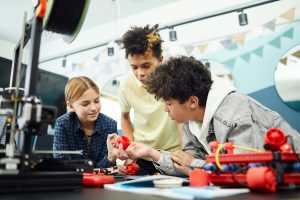Balancing Technology Use With Healthy Student Social Skills
In today’s digital age, technology has become an integral part of our daily lives, including the lives of students. From smartphones to laptops to social media platforms, there is an overwhelming amount of technology available at our fingertips. While technology has revolutionized the way we communicate and learn, it can also have negative impacts on our social skills if not used in moderation. As educators and parents, it is essential to find a balance between technology use and healthy student social skills. This article will delve into the importance of this balance and provide practical tips for achieving it.
The Impact of Technology on Student Social Skills
Before we dive into balancing technology use with healthy social skills, it is crucial to understand the impact of technology on students’ social skills. With the rise of social media, students are more connected than ever before. However, this constant connection can also have negative consequences.
Lack of Face-to-Face Communication
One of the most significant impacts of technology on social skills is the lack of face-to-face communication. With everything available online, students may be less likely to engage in face-to-face conversations, leading to decreased verbal communication skills. This can have a significant impact on their ability to express themselves and form meaningful relationships.
Decreased Empathy
Empathy is an essential aspect of healthy social skills. However, with technology, students may become desensitized to others’ feelings and emotions. Spending hours behind a screen can make it challenging to read social cues and understand others’ emotions, thus leading to a lack of empathy.
Social Comparison and Pressure
Social media platforms have made it easier for students to compare themselves to their peers. This can create unnecessary pressure to fit in, be popular, or have a certain image. This constant comparison can have a detrimental effect on their self-esteem and social skills.
Strategies for Balancing Technology Use and Healthy Social Skills
While it is essential to acknowledge the negative impacts of technology on social skills, it is equally vital to find a balance that allows students to reap the benefits of technology while developing healthy social skills. Here are some practical strategies for achieving this balance.
Set Technology-Free Time
As educators and parents, it is crucial to set boundaries around technology use. Designate specific times of the day or week where students are not allowed to use technology and encourage them to engage in face-to-face interactions. This could be during meal times, family game nights, or outdoor activities.
Promote Social Media Awareness
With social media being a significant presence in students’ lives, it is crucial to educate them about its potential negative effects. Talk to them about social media awareness, such as taking breaks, limiting scrolling time, and not comparing themselves to others. Encourage them to follow accounts that inspire them and make them feel good about themselves.
Encourage Extracurricular Activities
Extracurricular activities and hobbies provide students with opportunities to interact face-to-face, develop new skills, and build relationships. Encourage them to participate in activities that interest them, whether it’s joining a sports team, learning a new instrument, or volunteering in the community.
Lead by Example
As adults, it is essential to practice what we preach. If we want students to develop healthy social skills, we must lead by example. Set boundaries around your technology use and prioritize face-to-face interactions. Be present and engage in meaningful conversations with students, as this will encourage them to do the same.
The Bottom Line
It is undeniable that technology has its benefits, but it is crucial to find a balance between its use and healthy social skills. As educators and parents, we play a vital role in guiding students in striking this balance. By setting boundaries, promoting awareness, and encouraging face-to-face interactions, we can help students develop and maintain healthy social skills in today’s digital age.
No one can deny the impact of technology on our lives, but it is up to us to use it in a way that enhances our social skills and relationships, rather than hindering them. Let us strive for a harmonious coexistence between technology and healthy social skills for the betterment of today’s students and future generations.










